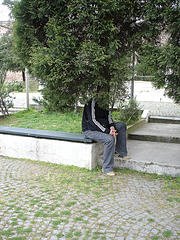
Stop Recycling. Start Repairing.
- Arne Hendriks & Joanna van der Zanden
We didn’t write the Repair Manifesto to safe the planet or because throwing away things without a clear reason seemed ridiculous. We wrote it, together with Cynthia Hathaway, because we love the repaired object and the trace it bares, the history it portrays and the care it reflects. We wrote it because repair adds beauty to our lives and sets us free.
1. Extending the life of your products creates the opportunity to built a relationship with things. Something that can’t be done in a world of recycled disposables. If there is truth in the idea that things have a soul, it is probably the soul we project as part of our memories and our experiences with that thing. Every time you throw away something needlessly, you throw away the possibility to enrich your relationship with the world. To us the repaired object is a sign of intimicy between man and object.
2. In The Wastemakers, published in 1960, Vance Packard writes how during the forties and fifties designers were almost forced to create disposable products. The quality of cars, appliances, homes and clothes went down, on purpose. Companies manufactured products with a very short lifespan. It is something the industry calls planned obscolesense. And it’s still everywhere. But it is important to understand that it hasn’t always been like that. It is a proces, and processes can be reversed.
3. The newest trend in the ‘repair industry’ is actually not repair at all. It is what’s called black-boxing. Designing black boxes that cannot be opened, That show nothing of the way they are made, that cannot be modified and that certainly cannot be repaired. Today’s cars for example are black-boxed to the extend that being an independant car repairman is almost impossible, or very boring. All they can do is throw away the broken unit and replace it with a new one, often creating much more waste then necessary. All road patrol can do these days when your car breaks down is pick up the phone and call for a tow truck. No more craftmanship, no more quick-fixes, no more creativity.
4. Repaired things are beautiful things. Not necessarily on the surface, although this is sometimes the case, but because of the story it tells. It tells us about the time consuming dedication or about speedy functionality. It tells about the nature of the accident and the resourcefulness of the mender. It tells about local customs and personal taste. About trends, glue, string, tape, tools, technique, time, and about so many other things.
5. In the first place things get repaired to restore functionality but it is also about challenging ourselves. Every broken item is a puzzle, sometimes literally, sometimes with missing pieces. And who doesn’t love solving puzzles. When it comes to repair there are puzzles for beginners, puzzles for the highly experienced and everything in between. Everyone can repair.
6. At some point industries started to appropriate models from fashion, where products go out of style so quickly you almost immediately after purchase feel the need to replace it. One fashion retailer even proclaimed: “We are not in this business to put beautiful clothes on woman, we are in this business to make women feel unhappy with the clothes they have in their closet.” Now multiply that idea with almost all the products we have...
7. Nothing teaches you more about a thing then taking it apart and figuring out how to fix it. And sometimes you learn that a thing can’t actually be fixed. Not because it is theoretically impossible, but because designers have made it impossible. On the other hand often things can be fixed so very very easily. Like this certain dvd player we had at Platform21 where we wrote the manifesto in 2009. We don’t actually know why, but everytime we open and close it, it works fine for several months, then decides to take a rest. We kind of loved that dvd-player for it.
8. It was both luck and misfortune that the Repair Manifesto was spread at the height of the recession. Luck because it probably was partly responsible for the enormous media coverage, and thus the spread of the word. But at the same time we worried that it would become synonoumous with the idea that we only had to repair things because there was a recession. We worried that people would think it was only the hardship that inspired repair creativity. And even if that is partly true, for us it was about the real value of repair, the real beauty, the real substance and mentality. Because otherwise, once the recession is over, so is repair and that would be a mistake.
9. In times when everybody has the same IKEA Billy in their bedroom, and we all drive the same cars, ride the same bikes, wear the same clothes and use the same gadgets, it is nice that through repair we can add a bit of personality to our products, and express our individuality.
10. We are becoming a people of button pushers. One push and everything works, or doesn’t. In a luxury car commercial we saw the other day it said: “You pay for it. But it owns you.” Another good reason to keep repairing our old cars, just to make sure it is clear who is in charge here.
11. Repair obviously has its limits. We don’t suggest you overdo it. Every product has its end, or becomes a museum piece. And when it comes to its end, it is a good thing it can be recycled. But because it still feeds our throw-away mentality, because it teaches us nothing, because it still feeds our arrogance against things, and because it is way less fun, until then we say: Stop recycling and start repairing!

